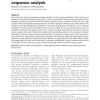470 search results - page 71 / 94 » An adaptive probabilistic trust model and its evaluation |
BIB
2006
13 years 8 months ago
2006
One of the major goals of computational sequence analysis is to find sequence similarities, which could serve as evidence of structural and functional conservation, as well as of ...
JSAC
2010
13 years 3 months ago
2010
Abstract--Sensor networks can benefit greatly from locationawareness, since it allows information gathered by the sensors to be tied to their physical locations. Ultra-wide bandwid...
IVC
2007
13 years 8 months ago
2007
This paper presents visual cues for object tracking in video sequences using particle filtering. A consistent histogram-based framework is developed for the analysis of colour, e...
WS
2005
ACM
14 years 2 months ago
2005
ACM
The pervasiveness of wireless devices and the architectural organization of wireless networks in distributed communities, where no notion of trust can be assumed, are the main rea...
QEST
2007
IEEE
14 years 3 months ago
2007
IEEE
We give an overview of GRIP, a symmetry reduction tool for the probabilistic model checker PRISM, together with experimental results for a selection of example specifications. 1 ...

